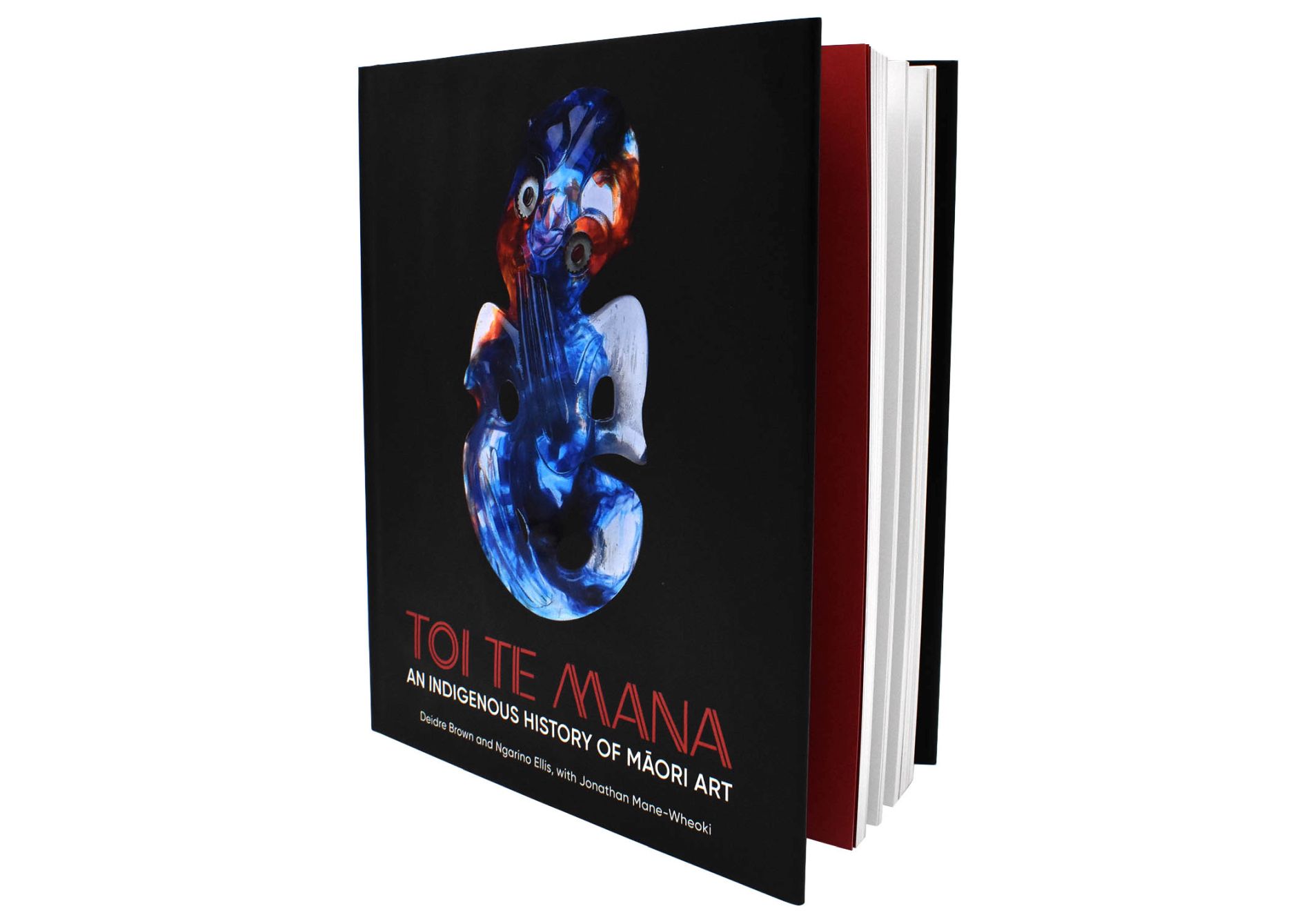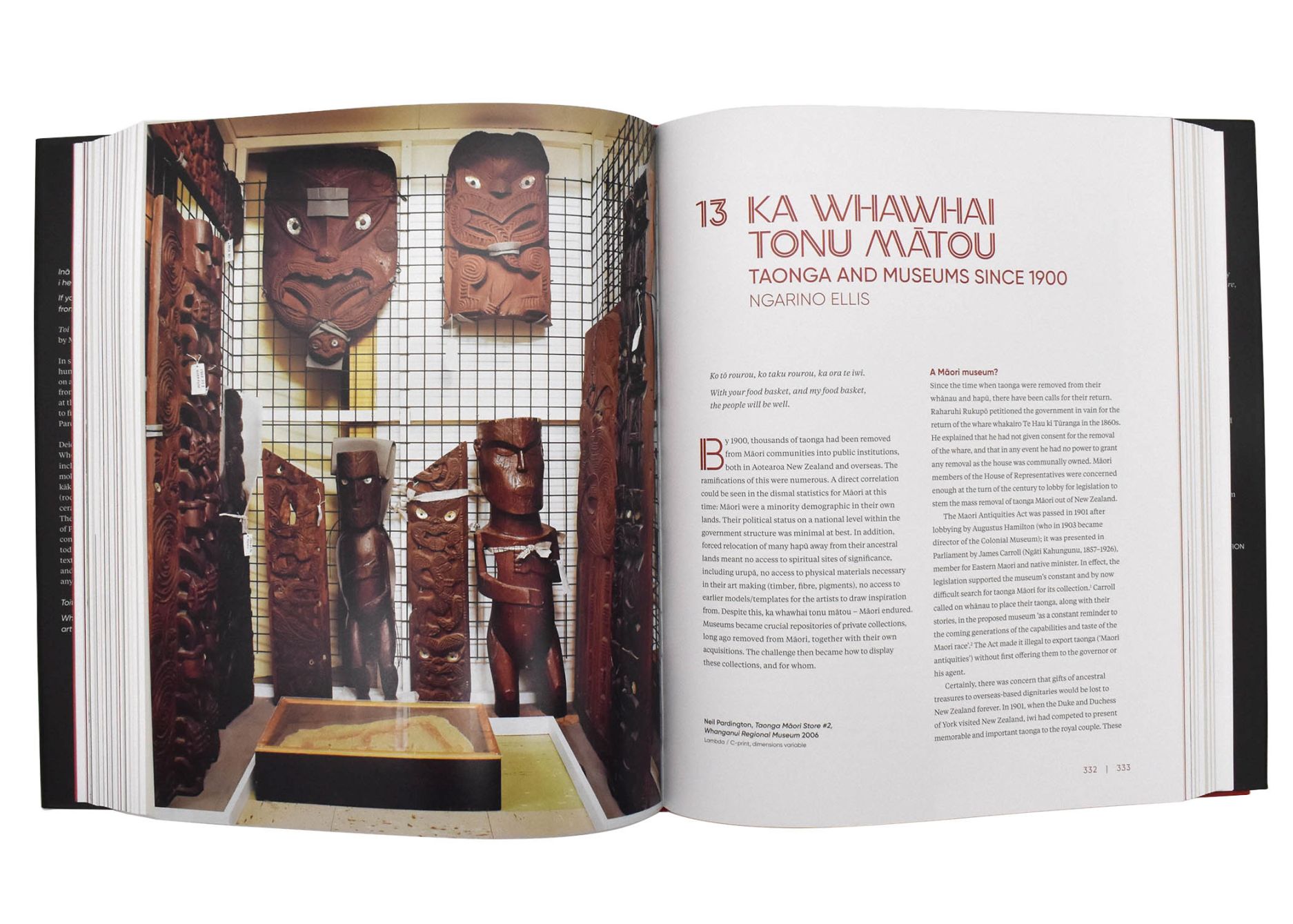Toi Te Mana
An Indigenous History of Maori Art
A landmark account in words and pictures of Māori art, by Māori art historians—from Polynesian voyaging waka to contemporary Māori artists.
He toi whakairo, he mana tangata.
Through artistic excellence, there is human dignity.
In six hundred pages and with over five hundred illustrations, this volume takes us on an extraordinary voyage through Māori art—from ancestral weavers to contemporary artists at the Venice Biennale, from whare whakairo to film, and from Te Puea Hērangi to Michael Parekōwhai.
Deidre Brown, Ngarino Ellis, and Jonathan Mane-Wheoki explore a wide field of art practices, including raranga (plaiting), whatu (weaving), moko (tattooing), whakairo (carving), rākai (jewellery), kākahu (textiles), whare (architecture), toi whenua (rock art), painting, photography, sculpture, ceramics, installation art, digital media, and film. The works discussed span a period from the arrival of Pacific voyagers eight hundred years ago to the contemporary artists working around the world today. With expansive chapters and breakout texts focusing on individual artists, movements, and events, Toi Te Mana is an essential book for anyone interested in te ao Māori.
He toi whakairo, he mana tangata.
Through artistic excellence, there is human dignity.
In six hundred pages and with over five hundred illustrations, this volume takes us on an extraordinary voyage through Māori art—from ancestral weavers to contemporary artists at the Venice Biennale, from whare whakairo to film, and from Te Puea Hērangi to Michael Parekōwhai.
Deidre Brown, Ngarino Ellis, and Jonathan Mane-Wheoki explore a wide field of art practices, including raranga (plaiting), whatu (weaving), moko (tattooing), whakairo (carving), rākai (jewellery), kākahu (textiles), whare (architecture), toi whenua (rock art), painting, photography, sculpture, ceramics, installation art, digital media, and film. The works discussed span a period from the arrival of Pacific voyagers eight hundred years ago to the contemporary artists working around the world today. With expansive chapters and breakout texts focusing on individual artists, movements, and events, Toi Te Mana is an essential book for anyone interested in te ao Māori.
616 pages | 584 color plates | 6.9 x 11.8 | © 2024
Abakanowicz Arts and Culture Collection
Anthropology: Cultural and Social Anthropology
Art: Art--General Studies
History: General History
Reviews
Table of Contents
He kupu whakataki—Preface
Tīmatanga kōrero—Introduction
Part 1—Te Kete Tuatea
1 Ngā momo waka: Moana, migration and Māori / Ngarino Ellis
Tā Hekenukumaingāiwi Busby, KNZM MBE (1932–2019) / Ngarino Ellis
2 Ngā toi whakairo: The arts of carving / Ngarino Ellis
The Taiapa brothers: Carving in the twentieth century / Ngarino Ellis
Morelli and the nineteenth-century papahou artist / Ngarino Ellis
Māori art and archaeology / Deidre Brown
3 Ngā kākahu: Textiles / Ngarino Ellis
Tahuaroa, pākūwhā and hākari: The display and gifting of taonga / Ngarino Ellis
Tihei mauri ora: The remaking of cloaks from museum collections / Ngarino Ellis
4 Ngā whare: Architecture / Deidre Brown and Ngarino Ellis
Pakaariki Harrison, QSO (1928–2008) / Ngarino Ellis
5 Ngā toi whenua: Rock art / Deidre Brown
6 Ngā taonga o Wharawhara: Body adornment / Ngarino Ellis
Areta Wilkinson / Deidre Brown
Pounamu / Ngarino Ellis
7 Mana wāhine, mana tāne, mana takatāpui: Depicting gender in Māori art / Ngarino Ellis
Men and weaving / Ngarino Ellis
Part 2—Te Kete Tuauri
8 Taonga, Māori and museums / Ngarino Ellis
Tāngata mamae: The tragic story of Te Maro, Ranginui and Te Kuku / Ngarino Ellis
Joseph Banks and the forty brass patu replicas / Ngarino Ellis
Tupaia / Ngarino Ellis
9 Māori art and the Christian missions / Deidre Brown
Hongi Hika’s self-portraits / Deidre Brown
Hone Heke’s ‘collar’ / Deidre Brown
He tikanga hōu? Figurative art in Rangitukia in 1838 / Ngarino Ellis
10 The art of utu / Deidre Brown
The Mātaatua wharenui / Jonathan Mane-Wheoki
11 Transforming cultures and traditions: New materials, ideas and technologies / Ngarino Ellis
Moko signatures and tino rangatiratanga / Ngarino Ellis
Early Māori drawings / Deidre Brown
The second age of iron / Deidre Brown
12 Ngā toi mōrehu: The arts of survival / Deidre Brown
Māori flags and banners / Deidre Brown
13 Ka whawhai tonu mātou: Taonga and museums since 1900 / Ngarino Ellis
Trick or taonga: The mysterious case of the green-painted patu pora / Deidre Brown
Fakes in the collection / Ngarino Ellis
Collecting the ancestors / Ngarino Ellis
Enrico Giglioli and the taonga collection in the Pigorini National Museum of Prehistory and Ethnography, Rome / Ngarino Ellis
Part 3—Te Kete Aronui
14 The art of social reform: Te Puea, Ngata and Rātana / Deidre Brown
Te Araiteuru pā at the 1906 New Zealand International Exhibition / Deidre Brown
15 The emergence of contemporary Māori art 1950–1975 / Jonathan Mane-Wheoki
Oriwa Haddon (1898–1958) / Deidre Brown and Jonathan Mane-Wheoki
Ramai Hayward (1916–2014) / Deidre Brown and Jonathan Mane-Wheoki
Pauline Kahurangi Yearbury (1926–1977) / Deidre Brown
16 Urban Māori art and architecture / Deidre Brown
Street art / Deidre Brown
17 A new tradition or old disruption? / Contemporary Māori exhibitions 1990–2021 / Deidre Brown
Māori architects and architectural designers / Deidre Brown
Māori designers / Deidre Brown
Māori Moving Image exhibition / Ngarino Ellis
Wairau Māori Art Gallery: The first public Māori art gallery / Deidre Brown
18 Māori art in Western Europe and Australia / Deidre Brown
Ngāti Rānana and Hinemihi / Deidre Brown and Ngarino Ellis
Māori art as a cultural property / Deidre Brown
19 Haumi ē! Hui ē! Tāiki ē! Māori and Indigenous art on the global stage / Ngarino Ellis
Ngā taonga uku: Māori ceramicists and clay workers / Deidre Brown
Contemporary Māori clothing / Deidre Brown
Advice to Māori artists / Jonathan Mane-Wheoki
Whakamutunga—Conclusion
Ngā pitopito kōrero—Notes
Kuputaka—Glossary
Rārangi pukapuka—Select bibliography
Kuputohu—Index
Tīmatanga kōrero—Introduction
Part 1—Te Kete Tuatea
1 Ngā momo waka: Moana, migration and Māori / Ngarino Ellis
Tā Hekenukumaingāiwi Busby, KNZM MBE (1932–2019) / Ngarino Ellis
2 Ngā toi whakairo: The arts of carving / Ngarino Ellis
The Taiapa brothers: Carving in the twentieth century / Ngarino Ellis
Morelli and the nineteenth-century papahou artist / Ngarino Ellis
Māori art and archaeology / Deidre Brown
3 Ngā kākahu: Textiles / Ngarino Ellis
Tahuaroa, pākūwhā and hākari: The display and gifting of taonga / Ngarino Ellis
Tihei mauri ora: The remaking of cloaks from museum collections / Ngarino Ellis
4 Ngā whare: Architecture / Deidre Brown and Ngarino Ellis
Pakaariki Harrison, QSO (1928–2008) / Ngarino Ellis
5 Ngā toi whenua: Rock art / Deidre Brown
6 Ngā taonga o Wharawhara: Body adornment / Ngarino Ellis
Areta Wilkinson / Deidre Brown
Pounamu / Ngarino Ellis
7 Mana wāhine, mana tāne, mana takatāpui: Depicting gender in Māori art / Ngarino Ellis
Men and weaving / Ngarino Ellis
Part 2—Te Kete Tuauri
8 Taonga, Māori and museums / Ngarino Ellis
Tāngata mamae: The tragic story of Te Maro, Ranginui and Te Kuku / Ngarino Ellis
Joseph Banks and the forty brass patu replicas / Ngarino Ellis
Tupaia / Ngarino Ellis
9 Māori art and the Christian missions / Deidre Brown
Hongi Hika’s self-portraits / Deidre Brown
Hone Heke’s ‘collar’ / Deidre Brown
He tikanga hōu? Figurative art in Rangitukia in 1838 / Ngarino Ellis
10 The art of utu / Deidre Brown
The Mātaatua wharenui / Jonathan Mane-Wheoki
11 Transforming cultures and traditions: New materials, ideas and technologies / Ngarino Ellis
Moko signatures and tino rangatiratanga / Ngarino Ellis
Early Māori drawings / Deidre Brown
The second age of iron / Deidre Brown
12 Ngā toi mōrehu: The arts of survival / Deidre Brown
Māori flags and banners / Deidre Brown
13 Ka whawhai tonu mātou: Taonga and museums since 1900 / Ngarino Ellis
Trick or taonga: The mysterious case of the green-painted patu pora / Deidre Brown
Fakes in the collection / Ngarino Ellis
Collecting the ancestors / Ngarino Ellis
Enrico Giglioli and the taonga collection in the Pigorini National Museum of Prehistory and Ethnography, Rome / Ngarino Ellis
Part 3—Te Kete Aronui
14 The art of social reform: Te Puea, Ngata and Rātana / Deidre Brown
Te Araiteuru pā at the 1906 New Zealand International Exhibition / Deidre Brown
15 The emergence of contemporary Māori art 1950–1975 / Jonathan Mane-Wheoki
Oriwa Haddon (1898–1958) / Deidre Brown and Jonathan Mane-Wheoki
Ramai Hayward (1916–2014) / Deidre Brown and Jonathan Mane-Wheoki
Pauline Kahurangi Yearbury (1926–1977) / Deidre Brown
16 Urban Māori art and architecture / Deidre Brown
Street art / Deidre Brown
17 A new tradition or old disruption? / Contemporary Māori exhibitions 1990–2021 / Deidre Brown
Māori architects and architectural designers / Deidre Brown
Māori designers / Deidre Brown
Māori Moving Image exhibition / Ngarino Ellis
Wairau Māori Art Gallery: The first public Māori art gallery / Deidre Brown
18 Māori art in Western Europe and Australia / Deidre Brown
Ngāti Rānana and Hinemihi / Deidre Brown and Ngarino Ellis
Māori art as a cultural property / Deidre Brown
19 Haumi ē! Hui ē! Tāiki ē! Māori and Indigenous art on the global stage / Ngarino Ellis
Ngā taonga uku: Māori ceramicists and clay workers / Deidre Brown
Contemporary Māori clothing / Deidre Brown
Advice to Māori artists / Jonathan Mane-Wheoki
Whakamutunga—Conclusion
Ngā pitopito kōrero—Notes
Kuputaka—Glossary
Rārangi pukapuka—Select bibliography
Kuputohu—Index
Awards
Apollo Magazine: Book of the Year
Won
Ockham New Zealand Book Awards: BookHub Award for Illustrated Non-Fiction
Won




